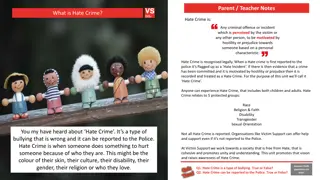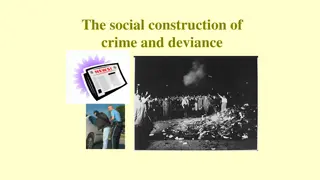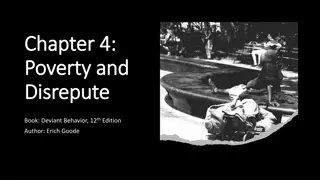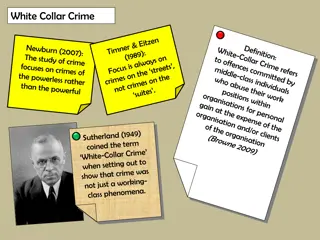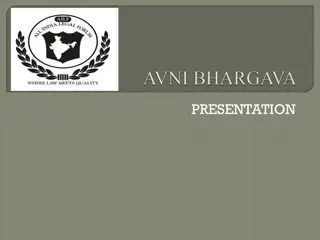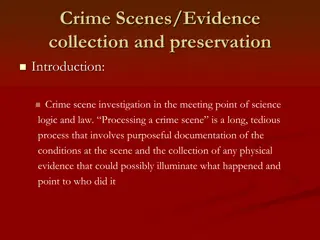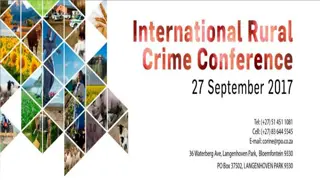Understanding Crime and Deviance: Control, Solutions, and Measurement
Exploring the concepts of crime and deviance, this content delves into various aspects such as types of deviance, agents of social control, solutions to crime, the penal system, methods of punishment, and measurement of crime through victim surveys and self-reported studies. It highlights the complexities of controlling criminal behavior, differentiating between formal and informal agents of social control, and addresses the challenges in accurately measuring crime rates due to the "Dark Figure of Crime."
Download Presentation

Please find below an Image/Link to download the presentation.
The content on the website is provided AS IS for your information and personal use only. It may not be sold, licensed, or shared on other websites without obtaining consent from the author. Download presentation by click this link. If you encounter any issues during the download, it is possible that the publisher has removed the file from their server.
E N D
Presentation Transcript
Revision Session Revision Session Topics to be covered Topics to be covered Crime and deviance Crime and deviance Youth Youth
Crime and deviance Crime and deviance
Crime and deviance Crime and deviance The types of deviance Cross-cultural deviance: Something that is deviant in some cultures e.g. having more than one wife Historical deviance: Something that is deviant only at a certain time e.g. slavery Situational deviance: Something that is deviant only in certain situations e.g. punching someone in the face during a boxing match. Deviance based on position/role: Something that is deviant for many but occupation/role may make it non- deviant e.g. a soldier shooting a member of the opposing army.
Controlling criminal behaviour Controlling criminal behaviour Agents of social control Formal and informal agents of social control Paul Willis (1977) on working class boys at school argued that there was a counter-school culture. He researched 12 boys and found that they chose not to conform to the norms and values of the school. He felt that their behaviour was not only due to peer group pressure, but actually had more to do with the influence of the workplace and the family. In 1977, Willis felt it was clear to the boys that working-class children got working-class jobs, and that, therefore, their school life was not important. Because of this they did not conform and did not care about the middle-class norms and values the teachers were trying to force upon them. Willis findings confirm that our behaviour is controlled in a variety of ways.
Solutions to crime Solutions to crime The functions of the penal system Methods of punishment
Measurement of crime Measurement of crime - -The Dark Figure Of Crime The Dark Figure Of Crime There are several different ways of measuring the crime rate. Victim surveys and self-reported studies have been developed in order to try to reveal more of the dark figure and so get a more valid picture of crime and criminals than that produced by the official statistics. None of the methods are perfect, however, and we must, therefore, be careful when coming to any conclusion about who is actually committing crime in society and how much crime is going on.
Measurement of crime Measurement of crime - -Patterns of crime crime Victim surveys Normally a large scale sample where people are interviewed about what crimes they have been a victim of in the last year. A better way of uncovering a more valid picture of crime than the official statistics, because it removes the problem of the non-reporting and non-recording of crime. Probably the best-known victim survey is the British Crime Survey, which is carried out every year on a national sample of people. Patterns of
Measurement of crime Measurement of crime - - Problems with victims surveys victims surveys There are no guarantees that information There are no guarantees that information given in interviews is actually accurate given in interviews is actually accurate. People under the age of 16 are not People under the age of 16 are not interviewed. interviewed. Some sociologists question how useful a national crime survey actually is national crime survey actually is. Problems with useful a
Measurement of crime Measurement of crime- - self report studies studies This time people are asked what crimes they have committed, usually by having them tick off from a list what they have done. Everything is anonymous and confidentiality is assured. This is thought to encourage respondents to be more truthful. This methods increases validity because whether the crime has been reported and the criminal convicted becomes irrelevant. It allows researchers to measure the amount of crime committed by those people who have never appeared in the official statistics. self report
Measurement of crime Measurement of crime- - self report studies studies Many people are reluctant to take part . Those people that do take part may not tell the truth. These reports are usually completed with young people- there are therefore not representative of all crimes committed. The reports often focus on delinquent rather than criminal behaviour and so are limited in their usefulness. self report
The impact of crime on the community The impact of crime on the community Many people believe that it is the fear of crime, rather than the reality, that controls our behaviour and thoughts. Obviously this is closely linked to the sensationalist and often stereotyped reporting in the media. On a positive level, some communities may benefit from punishments for criminals that require them to do community work such as removing graffiti or tidying public gardens. The negative is that people end up living in fear, homes armed with every security device on the market, and neighbours that do not know or trust one another.
Explanations of crime Explanations of crime
Explanations of crime Explanations of crime Age Age Peer pressure Subculture Boredom Lack of social control at home and in education Labelling theory Cicourel Cicourel (1976) (1976)
Explanations of crime Explanations of crime Gender Gender Differential gender socialisation Oakley (1981) Different levels of social control Gender stereotyping
Explanations of crime Explanations of crime Ethnicity Ethnicity Poverty and unemployment Police targeting Discrimination and racism in the criminal justice system (self-fulfilling prophecy) Different norms and values
Social class Social class Socialisation and subculture Lack of opportunities Status frustration Marxism
Possible 24 mark questions More powerful formal agents of social control are the only way to reduce crime. If `capital punishment was reintroduced, all crime would be reduced. Official statistics are completely useless. The structure of society is what leads people to crime.
24 mark questions All deviance is relative. Crime would stop if parents took control of their children. The reintroduction of the death penalty would solve all crime. Using the victim surveys is the only way to get a true picture of crime. People commit crime because they are bored.
Youth Sociologist Philippe Aries (1962) believed that the concept of childhood was only invented in the Middle Ages. He stated that before that, at the age of six, children became miniature adults.
The invention of childhood 1700s: At a young age children learnt a craft. Girls didn t learn to read or write, depending on how rich their families were. Some girls were married by 12. Early 1900s: 1870 Education Act children had to go to school from 5-10. They learnt a curriculum based on their gender and given the cane if they behaved badly. Due to employment acts children under 8 no longer worked in the mines, up chimneys or in the factories. Late 1900s: Butler Act 1944- children stayed at school until 15, raised to 16 in 1973. 1988 Education Act boys and girls all learnt the same curriculum. 21st century: Children cannot be hit by a family member if it leaves a bruise. 2009: Children have to go to school until they are 16 (planned to increase to 18 by 2015). Children can work, but not during school hours. Children cannot marry until they are 16 (if their parents agree) but they can fight for their country!
The disappearance of childhood The disappearance of childhood Neil Postman (1983) The adult messages children see every day in the mass media, they become confused little adults . He called these children tweenagers and used examples of underage drinking ,smoking and underage sex as evidence.
Biological or Social Construction? Biological or Social Construction? Youth is a term that people define in different ways and apply to different age groups. This can be seen when looking at the laws for young people. Many do however define youth as the period between childhood and adulthood. Sociologists are interested in whether youth is actually a specific biological stage or something that society creates and defines.
Social construction Biological The law, in every society the rights and responsibilities of young people differ greatly. E.g. in England you must be 17 to drive, in many US states you can drive at 16. Social norms and customs vary. In England the average age for a female to marry is just over 27, in Niger it is just over 17. Emotional and behavioural norms: Whilst it is often believed that for all youth life is confusing and emotional, some sociologists such as Margaret Mead (1927) argue that this is not the case in every society. Mead claimed that Samoan young people did not have this period of turmoil. Biologically, all youth go through hormonal changes at puberty. Young people experience changes in both their attitudes and behaviour. Many young people go through times of being irritable and unsure of themselves.
Transition Transition It appears that youth may be more related to change and transition, than to biological age. It could be seen as a time that allows a young person to leave behind childhood ideas and behaviour and become an adult. In some cultures it is a time of experimenting with adult roles, such as beginning part-time work. In the contemporary UK this transition may include learning to drive, whereas in other cultures it may be marked very differently. The ceremonies and proceedings used to mark the transition from childhood to adulthood are often known as wither rites of passages or initiation rites.
The peer group as an agent of social control The peer group as an agent of social control A peer group is others of the same age, with the same background, interests and social status. Many young people feel that their peer group is a main agent of social control. Although it is informal agent, the influence of a peer group when we are 15 can be very strong. Often it is fear of rejection or being laughed at that controls our behaviour. However, sanctions can also be verbal or physical. It is the pressure to conform from our peers that make us decide to follow this agent of social control rather than another. For example, you might have to decide whether to go home on time, as dictated by your family, or to stay out longer, as dictated by your peer group. Peer group pressure is often stronger at different points in our lives. In the media, peer group pressure is commonly associated with negative behaviour, but it can be positive. Your peer group can convince you not to break the law or complete your homework. This is known as positive peer pressure, as it helps you to conform to society s norms and values.
Youth subculture Youth subculture The idea that all young people have a similar set of norms and values, which is different to that of other age groups, is known as youth culture. Young people are connected by norms that are created by: The legal position of young people- e.g. the norm of attending school The biological changes that young people go through e.g. mood swings Society s expectations of young people e.g. the norm of not being a parent.
Youth subculture Youth subculture Youth subcultures = Different cultures that are within youth culture. The youth subculture we chose to mix with partly defines our identity. The different features of identity are: Behaviour Attitudes Music Leisure activities Dress and hairstyle
Youth subcultures can link people with similar interests and create identity, but some youth may choose to join based on their biological or social characteristics.
Class Class Some subcultures seem to unite young people of similar economic status. J Clarke (1976) researched Skinhead culture and wrote that it united members of the working class, allowing its members to release their frustration at being poor and unemployed.
Ethnicity Ethnicity Ethnicity clearly links some groups of young people. Studies of Bhangra claim that this music from the Punjab has created a youth subculture. It incorporates music, style and dance which have now spread to a wide audience. This subculture has crossed over to mainstream culture, as seen through fusion music such as Apache Indian which combines Bhangra and hip hop.
Gender Gender In the 1970s, some sociologists argued that young teenage girls were part of a gendered subculture. McRobbie and Garber (1976) referred to this as a bedroom subculture. They wrote that it existed separately from boys, who were hanging out in public. They interviewed a group of girls and found that their culture was led by the media and involved experimenting with hair and make-up and discussing boys in their bedrooms.
The growth of youth cultures and subcultures The growth of youth cultures and subcultures In the 1950s, Britain experienced a growth of affluence. This meant that British people had some money to spend, as they were richer. Young people who were leaving school at 15 had jobs and, therefore, had money to spend on their chosen subculture, its music and fashion. As time went on and the school leaving age rose, young people had even more time to spend on their chosen subculture. Business owners and advertisers wanted the young people s money, so they started making products and marketing them to the young- known as manipulation by the media.
Reasons to join a subculture Reasons to join a subculture Shared interests: such as music, style and fashion. Rites of passage: all young people, before they become adults, experiment and try to be their own person through different subcultures. Solution to problems: for example, if you are facing racism, you may choose to join others and, therefore, share your problems. Peer group pressure: this may make you feel you have to join in.
Key aspects of being in a gang Key aspects of being in a gang Territory: gangs are often associated with an area. Recently the media have highlighted the growth of signature graffiti, which includes the use of a postcode. The gang will feel some ownership over an area and see any uninvited entry by other gangs as an aggressive act. Tag wars using graffiti are an example of this. Delinquent subculture: gangs are bound by different norms and values from those of other young people, usually associated with law breaking. Whether through drug selling, violence or tagging, membership of these groups is often about taking risks and committing crime. Loyalty: gangs are bound together by the rule that membership means you must pledge allegiance to the gang. A member must be prepared to do anything for the gang when asked. Hierarchy: gangs often have a clear hierarchy with a known leader or leaders. They are often seen to be well organised, although some studies show this is not the case for all gangs.
Reasons for joining a gang Reasons for joining a gang Boredom: for many joining a gang is relief from boredom. It is little more than something to do. Family: fictional presentation of gangs in the media focus on the idea that young people who join gangs are lacking in family and/or role models Friendship:for some, the people they hang out with are merely their friendship groups rather than a gang. The media sometimes reports normal youth behaviour as gang behaviour. Their uniform appearance is due to shared tastes and their behaviour is just related to friends having fun. The supposed hierarchy, with a known leader, is just the norm of a group where some take on a role as leader, whilst others take on the role of followers. The strong loyalty of the group results from the value we have for friends.
Reasons for joining a gang Reasons for joining a gang Status frustration: Albert Cohen (1955) stated that some working class children in the USA fail to succeed in school and have little social status. Due to this he noted that some, out of resentment, join a group which has different norms and values to the society in which they are a failure. In this new group or gang, the young person can gain a new, higher status due to the different (often delinquent) norms and values. Sense of belonging:Walter Miller (1958) felt that adolescence is a time when young people often feel lonely and unsure of themselves. As a result they feel the need to belong, to fit in. for this reason gang membership is popular as it offers a sense of belonging.
Reasons for joining a gang Reasons for joining a gang Social network: In Howard Williamson s study Milltown Boys (1997), after observing a delinquent gang for some time, he concluded that it was not organised. Although the gang cared about territory and hierarchy, they were not focused on illegal activities it was more about having a social network. Peer group pressure: In some films, gang membership is presented as a rite of passage in the area depicted. It is not optional. Joining the gang is what you have to do or you will be picked on as a nonnie .
24 mark questions Youth Innocence has been eroded. Youth is just a biological stage. Peers are the most important agent of social control for teenagers. Youth subcultures exist only because of class divides. Young people join gangs because they have similar interests. Family We only need families for economic support. Roles in the family are no where near equal. Family life has not changed much since the 1950s. Marriage will never disappear. It is always best to raise children in a nuclear family.
Mind pegs Postman (1983) tweenagers, underage drinking and smoking. MINTEL survey 90% of 14 year olds worn make up (2004) Girl magazines such as Bliss and Cosmo Girl giving away vouchers for free tanning Child too aware of their bodies and worried about adult issues e.g. sexuality Comparing life to the 1700-1800s children have a longer childhood. They do not need to work and cannot get married at 12. The law cannot be held criminal responsible before 10 (8 in Scotland) treated as a minor until 18. Physical element of childhood cannot ever disappear
Mind pegs Postman (1983) tweenagers, underage drinking and smoking. MINTEL survey 90% of 14 year olds worn make up (2004). Girl magazines such as Bliss and Cosmo Girl giving away vouchers for free tanning. Child too aware of their bodies and worried about adult issues e.g. sexuality. Comparing life to the 1700- 1800s children have a longer childhood. They do not need to work and cannot get married at 12. The law cannot be held criminal responsible before 10 (8 in Scotland) treated as a minor until 18. Physical element of childhood cannot ever disappear.
Possible 24 mark questions Innocence has been eroded. Youth is just a biological stage. Peers are the most important agent of social control for teenagers. Young people only join a subculture because they like the clothes.
24 mark questions All deviance is relative. Crime would stop if parents took control of their children. The reintroduction of the death penalty would solve all crime. Using the victim surveys is the only way to get a true picture of crime. People commit crime because they are bored.






